Price action trading is a popular strategy that traders use to analyse and trade financial markets. This strategy is based on analysing and interpreting the price movement of a financial instrument to make informed trading decisions. Price action traders use charts, patterns, and technical analysis tools to identify price movements, trends, and patterns in the market.
As a forex trader, you likely use convertisseur devises to calculate the value of foreign currencies. But how do you make profits trading foreign currencies? This article will cover price action trading, how it works, the tools and strategies used, the advantages and disadvantages of price action trading, and some tips for beginners.
Plan de l'article
What is Price Action Trading?
Price action trading is a strategy for analysing a financial instrument’s price movement to make trading decisions. Price action traders use charts, patterns, and technical analysis tools to identify price movements, trends, and patterns in the market.
Price action trading involves studying and interpreting the movement of price and volume data, using charts and technical indicators to identify trading opportunities. Traders who use price action trading focus on understanding the market’s psychology, which is reflected in the price action of a financial instrument.
How Does Price Action Trading work?
Price action trading works by analysing the price movement of a financial instrument over a certain period. Traders use charts and technical analysis tools to identify market price movements, trends, and patterns.
Price action traders believe that the market reflects the psychology of the market participants, influences all the information available to it, and price movements. Price action traders use this information to make trading decisions.
Price action trading is based on the following principles:
- Price reflects all the information that is available to the market.
- The psychology of the market participants influences the market.
- The price movement of a financial instrument tends to repeat itself over time.
Price action traders use charts and technical analysis tools to identify price movements, trends, patterns, and important changes in the market. They use technical indicators such as moving averages, oscillators, and support and resistance levels to identify potential trading opportunities.
Price action traders also use candlestick charts to identify patterns in the market. Candlestick charts show the opening, closing, and high and low prices for a specific period. Candlestick patterns can provide important clues about the market sentiment and the direction of the price movement.
Tools and Strategies used in Price Action Trading
Price action traders use various tools and strategies to analyse the market and make trading decisions. Commonly used tools and strategies in price action trading include:
- Candlestick charts: Candlestick charts are used to identify patterns in the market. These patterns can provide important clues about the market sentiment and the direction of the price movement.
- Technical indicators: Moving averages, oscillators, and support and resistance levels are used to identify potential trading opportunities.
- Trend lines: Trend lines also help to identify the direction of the price movement. Traders draw trend lines on the chart to connect the highs or lows of the price movement.
- Price patterns: Price patterns such as head and shoulders, double tops, and double bottoms are used to identify potential trading opportunities.
- Price action analysis: Price action analysis involves analysing a financial instrument’s price movement without technical indicators. Price action traders use this analysis to identify potential trading opportunities.
Advantages and Disadvantages of Price Action Trading
Price action trading is a popular approach to trading financial markets that involves using the price movements of an asset to predict price. Here are some advantages and disadvantages of price action trading:

Advantages:
- Simple and effective: Price action trading is a simple and effective way to trade markets. It does not involve using complicated indicators or algorithms, which can confuse and overwhelm some traders. Instead, it relies on analysing price movements, which are easy to understand and interpret.
- Flexibility: Price action trading can be applied to any financial market, including stocks, forex, commodities, and cryptocurrencies. This means traders can use the same approach across different markets and assets, saving time and effort.
- Increased accuracy: Price action trading can give traders a more accurate market picture. By analysing price movements, traders can identify critical levels of support and resistance, which can help them make better trading decisions.
- Helps to manage risk: Price action trading can help traders manage risk more effectively. By identifying critical support and resistance levels, traders can set stop-loss orders and limit their losses if the market moves against them.
Disadvantages
- Requires discipline and patience: Price action trading involves a lot of discipline and patience. Traders need to be able to wait for the proper setup to occur and not enter trades based on impulse or emotion.
- Subjective analysis: Price action trading is a subjective form of analysis. Traders need to interpret price movements and identify critical levels of support and resistance, which can lead to different conclusions depending on the trader’s perspective.
- Limited use of indicators: Price action trading does not rely on indicators, which can limit its usefulness in certain market conditions. For example, price action trading may need to provide more information to make informed trading decisions in different market scenarios.
Why Become a Price Action Trader?
Trading price action is often referred to as trading the naked charts without the distraction of indicators. Price action traders consider indicators useful tools but gradually remove them as they progress. As a beginner in price action trading, it is best to use indicators until you gain accuracy in analysing charts without them.
Price action helps traders see the market as it is, considering all the factors and market forces, as the charts reveal. Price action trading will help you learn the smart money concept (also known as institutional trading), which is often the next step after learning price action.


